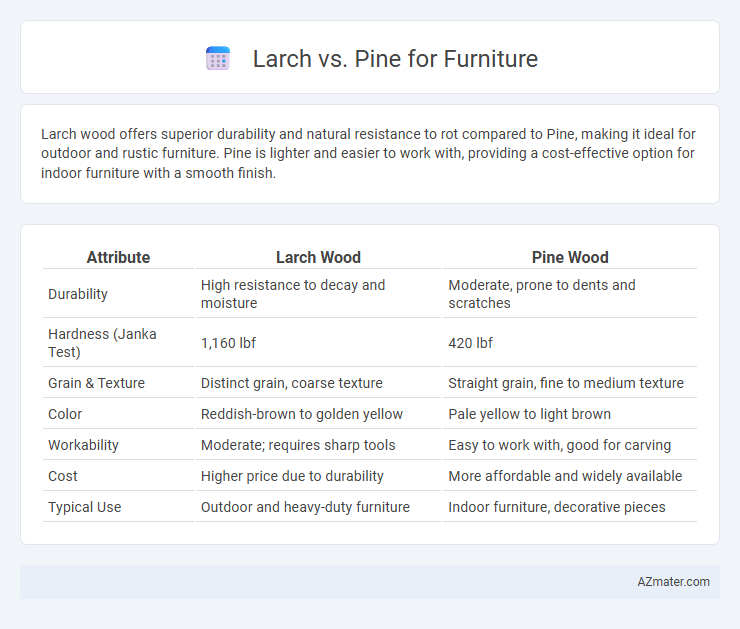Larch wood offers superior durability and natural resistance to rot compared to Pine, making it ideal for outdoor and rustic furniture. Pine is lighter and easier to work with, providing a cost-effective option for indoor furniture with a smooth finish.
Table of Comparison
| Attribute | Larch Wood | Pine Wood |
|---|---|---|
| Durability | High resistance to decay and moisture | Moderate, prone to dents and scratches |
| Hardness (Janka Test) | 1,160 lbf | 420 lbf |
| Grain & Texture | Distinct grain, coarse texture | Straight grain, fine to medium texture |
| Color | Reddish-brown to golden yellow | Pale yellow to light brown |
| Workability | Moderate; requires sharp tools | Easy to work with, good for carving |
| Cost | Higher price due to durability | More affordable and widely available |
| Typical Use | Outdoor and heavy-duty furniture | Indoor furniture, decorative pieces |
Introduction: Larch vs Pine for Furniture
Larch wood offers exceptional durability and water resistance, making it ideal for furniture exposed to moisture or outdoor settings. Pine wood is softer, lighter, and easier to work with, providing a warm appearance suitable for indoor furniture and decorative pieces. Selecting between larch and pine depends on the desired furniture strength, longevity, and aesthetic appeal.
Wood Characteristics: Larch and Pine
Larch wood is dense and durable, featuring a tight grain and high resin content that increases its natural resistance to water and decay, making it ideal for outdoor furniture. Pine is lighter and softer with a more uniform, straight grain, which allows for easier cutting and shaping but makes it more susceptible to dents and scratches. Both woods offer distinct aesthetics: larch has a rich reddish-brown hue, while pine displays a paler yellow tone with prominent knots.
Appearance and Grain Patterns
Larch wood features a distinctive reddish-brown hue with pronounced, irregular grain patterns that add a rustic and textured aesthetic to furniture, making each piece unique. Pine offers a lighter, yellowish tone with more uniform, straight grain lines and occasional knots, creating a classic and clean look preferred in traditional and country-style furniture. The choice between larch and pine for furniture depends on the desired visual impact: larch provides a bold, rugged appeal, while pine delivers a softer, more consistent appearance.
Durability and Strength Comparison
Larch wood exhibits higher natural durability and resistance to decay compared to pine, making it a preferred choice for long-lasting furniture exposed to moisture or outdoor conditions. Its dense grain structure contributes to superior strength and hardness, allowing larch furniture to withstand heavy use and resist dents better than softer pine varieties. Pine, while easier to work with and more affordable, has lower strength and durability, often requiring treatments or finishes to enhance its lifespan in furniture applications.
Workability and Ease of Use
Larch wood offers moderate workability with its dense grain, requiring sharp tools for smooth cuts, making it slightly harder to shape compared to pine. Pine's softer texture and straight grain enhance ease of use, allowing for quick sanding, cutting, and joining, ideal for detailed woodworking projects. Furniture makers often prefer pine for intricate designs while larch is chosen for durability and resistance to wear.
Resistance to Decay and Moisture
Larch wood offers superior resistance to decay and moisture compared to Pine, making it a better choice for outdoor furniture exposed to harsh weather conditions. Its dense natural resin content provides exceptional durability against fungal attacks and water absorption. Pine, while more affordable, tends to be more porous and less resistant to moisture, requiring additional treatment to enhance its longevity in damp environments.
Cost Differences: Larch vs Pine
Larch wood tends to be more expensive than pine due to its higher density and greater durability, making it a premium choice for furniture that requires long-lasting strength. Pine, being softer and more abundant, offers a budget-friendly option with easier workability but may require more maintenance over time. Cost differences between larch and pine furniture often reflect these material properties, with larch commanding higher prices but providing enhanced longevity and resistance to wear.
Best Uses for Each Wood Type
Larch wood offers exceptional durability and natural resistance to decay, making it ideal for outdoor furniture and rustic interior pieces that require longevity and weather resistance. Pine wood is lightweight and easy to work with, preferred for indoor furniture such as cabinets, shelves, and children's furniture due to its smooth finish and affordability. Larch's tight grain and density suit structural uses, while Pine's softer texture supports decorative and painted furniture applications.
Sustainability and Environmental Impact
Larch wood offers superior sustainability due to its rapid growth rate and natural resistance to pests, reducing the need for chemical treatments compared to pine. Pine, while abundant and fast-growing, often requires more intensive forestry management and chemical preservation, which can elevate its environmental footprint. Choosing larch for furniture minimizes ecological impact by utilizing a durable, naturally resilient timber that supports responsible forest management practices.
Conclusion: Choosing Between Larch and Pine
Larch offers superior durability and natural resistance to decay, making it ideal for furniture that requires long-term sturdiness and outdoor use. Pine provides a lighter, more affordable option with ease of customization and a warm aesthetic suitable for indoor furniture and decorative pieces. Selecting between larch and pine depends on the balance between durability needs and budget constraints for your specific furniture project.

Infographic: Larch vs Pine for Furniture
 azmater.com
azmater.com